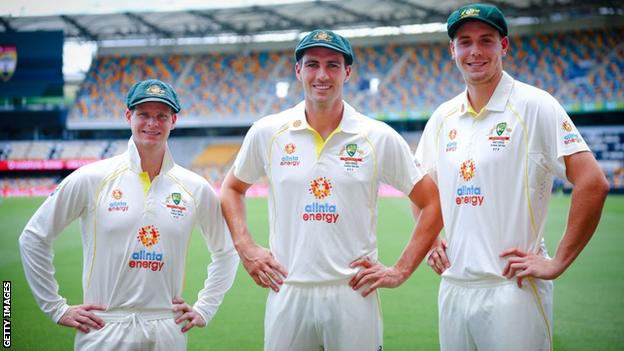ARTICLE AD BOX
 Cameron Green, right, towers above his team-mates at 6ft 5ins
Cameron Green, right, towers above his team-mates at 6ft 5ins| Venue: Adelaide Oval Date: 16-20 December Time: 04:00 GMT |
| Coverage: Daily highlights show on BBC iPlayer, ball-by-ball commentary on Test Match Special, plus live text commentary, UK-only clips, features and analysis on the BBC Sport website and app |
To offer a small piece of understatement, Cameron Green stands out.
Cricketers just shy of two metres tall tend to do that.
As Australia knocked over England at the Gabba in the first Ashes Test this week, Green stood out with the ball: arriving at the crease in a full gallop, blond hair flying, sending down the Kookaburra ball at pace, creating movement, extracting bounce commensurate with his frame.
In the first innings, he took out England's Ollie Pope when he was well set, hurried on a hook shot that was top-edged down to a catcher on the boundary.
In the second innings, he removed England's most important player in Joe Root, with that extra bounce playing a major part in drawing an edge behind. Green then finished off his match by removing Chris Woakes.
For the year or so before this season, though, most of the attention has not been on Green's bowling.
"There was a lot of chat a couple of years ago that he was one of the next best quicks, a really hard worker," said his captain Pat Cummins after the Brisbane Test. "Then he started churning out hundreds."
After two seasons for Western Australia operating as a bowler and batting at number eight or nine, Green made four centuries in his third season. He followed up in 2020-21 with 197 and 251 for Western Australia, before making a hundred against India for Australia A.
Next thing he was into the Test team at number six. Green is such a talent that no-one can decide where they should look.
His first Test summer didn't let him bowl with freedom. He sent down holding overs and didn't take a wicket across four Tests.
The series was "literally straight after a stress fracture," said Cummins, "so not only did we not want to put too many overs into him on the ground, but little things like preparing for games and getting overs in and working on things in the nets, he just didn't have a lot of bowling behind him."
Now things have changed.
"He's had a really good pre-season, bowled a bit more in the Shield, and he's back to what he was bowling a couple of years ago," said Cummins.
Green grew up, literally, in suburban Perth, near the former Australia rules football stronghold of Subiaco. He would have been right at home in that format as a centre-half forward, with midfielders dropping the ball onto his head and few defenders having a chance to spoil it.
He was playing first-grade cricket by the age of 16, dominating with runs and wickets, before being fast-tracked into Cricket Australia pathway matches, and playing first-class state cricket before his 18th birthday.
As Cummins indicated, the excitement at that level was about his ability with the ball. But the runs didn't take long to catch up.
Now he's embedded for a decent stint in the national team by the age of 22, due to be given time to grow into his role.
For England players so accustomed to facing Cummins, Josh Hazlewood, Nathan Lyon and Mitchell Starc, the work of Green shapes as influential over the next four Ashes Tests.
Even England captain Joe Root was cautiously complimentary in Brisbane: "I think he bowled well throughout the whole game. I thought for the majority of it we managed him pretty well. He has a slightly different action to the other guys, so trying to get used to that, it's nice to get that in the bank ahead of the rest of the series. But we knew he was a talented player."
For his teammates, especially his bowling colleagues, Green's presence shapes as an unfamiliar bonus.
The Australian men's Test team has yearned for an all-rounder for years, toying unsuccessfully with options like Mitchell Marsh, Hilton Cartwright, and Moises Henriques.
None has offered more than useful medium pace. Green is shaping as a genuine pace option, who can substantial extra rest to the frontline three quicks, or allow two spinners to be played with confidence in helpful conditions.
That search has spanned Lyon's entire 101-Test career. In Brisbane, the often taciturn off-spinner was effusive about his view of Green's bowling from cover point.
"To be fielding square of the wicket, I'm pretty used to seeing Josh, Pat, and Starcy hit the wicket and the pace and bounce that they get. But I was blown away with Greeny's rhythm, the way he's come in and whacked the pitch to get something out of it," said Lyon.
"I'm proper excited about his skillset. His belief will keep growing day by day, training session by training session, and Test by Test. He's going to be an unbelievable asset for Australian cricket for a long period of time, hopefully."
That final word is the caveat, the spectre of injury that always shadows young bowlers. Things can change quickly, and the future is not guaranteed. But given the consistency of improvement behind Green's rapid rise, Australia can afford to have optimism.

 2 years ago
75
2 years ago
75








 English (US)
English (US)